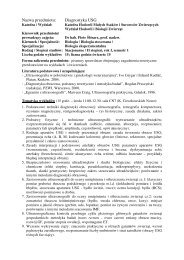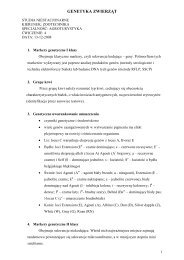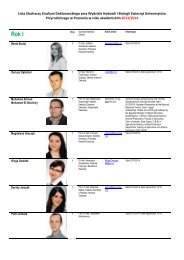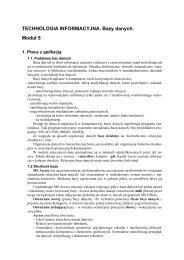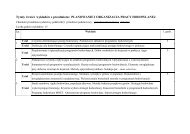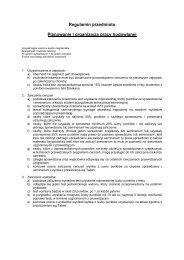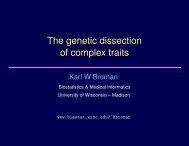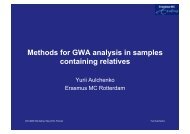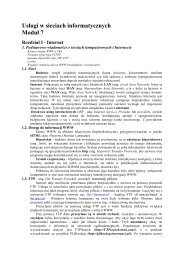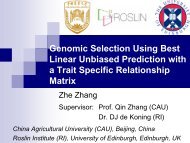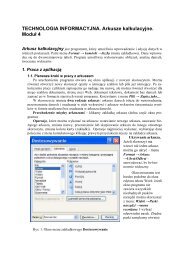The book of abstracts is available. - PoznaÅ
The book of abstracts is available. - PoznaÅ
The book of abstracts is available. - PoznaÅ
You also want an ePaper? Increase the reach of your titles
YUMPU automatically turns print PDFs into web optimized ePapers that Google loves.
14 th QTL-MAS Workshop, Poznań University <strong>of</strong> Life Sciences, Poland 2010Testing association <strong>of</strong> genotypes with d<strong>is</strong>crete and continuous traitsKacper Żukowski 1∗ , Anna Macierzyńska 1 , Heliodor Wierzbicki 11Department <strong>of</strong> Genetics and Animal Breeding, Wrocław University <strong>of</strong> Environmental and Life Sciences,Kożuchowska 7, 51-631 Wrocław, Poland∗ Presenting author: Kacper Żukowski, email: kacper.zukowski@up.wroc.plBackground . <strong>The</strong> aim <strong>of</strong> th<strong>is</strong> study was to predict breeding values <strong>of</strong> continuous and binarytrait and to investigate associations between genetic markers and both traits. Differentapproaches were used to investigate both traits – some <strong>of</strong> them considered each traitseparately and the other considered traits simultaneously.Methods. Three groups <strong>of</strong> models were used. First group, named BLUP, was used forinvestigating associations between SNPs and continuous and binary trait. SNP’s effects weretreated as random whereas mean and gender were treated as fixed effects. <strong>The</strong> second group<strong>of</strong> models, named gBLUP, was applied to predict genomic breeding values, which wereconsidered as random effects. <strong>The</strong> fixed effects were analogical as in the first group <strong>of</strong>models. In both a. m. groups, two models considered both traits simultaneously. <strong>The</strong>n onetrait was put as the fixed effect in the model for the second trait. <strong>The</strong> third group <strong>of</strong> models,named Foulley’s methods, considered both traits simultaneously. <strong>The</strong>n the fixed and therandom effects for both traits were estimated in the same time (Foulley et al., 1983). Foulley’smethods were used to predict breeding values and to estimate SNPs effects, which weretreated as random effects. Results received from Foulley’s method were compared withresults obtained using two first groups <strong>of</strong> models.Results and Conclusions. <strong>The</strong> correlation between EBV and GEBV for the quantitative traitwas 0.67 for animals with phenotype and for all animals. For the binary trait accuracy was0.78 for all animals and 0.84 for animals with phenotype. Results obtained suggest thatadditive effect <strong>of</strong> SNPs in genome were not the same for the quantitative and the binary trait.Foulley J.L., Gianola D., Thompson R. (1983) Prediction <strong>of</strong> genetic merit from data on binary and quantitativevariates with an application to calving difficulty, birth weight and pelvic opening. Genet. Sel. Evol., 15(3), 401– 42421



